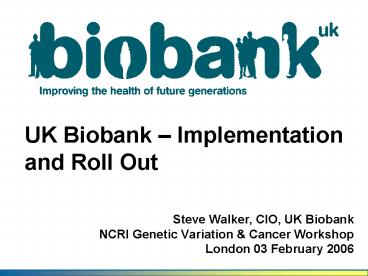Steve Walker, CIO, UK Biobank NCRI Genetic Variation - PowerPoint PPT Presentation
1 / 24
Title:
Steve Walker, CIO, UK Biobank NCRI Genetic Variation
Description:
Steve Walker, CIO, UK Biobank. NCRI Genetic Variation & Cancer Workshop. London ... physical activities like heavy lifting, digging, aerobics or fast cycling? ... – PowerPoint PPT presentation
Number of Views:298
Avg rating:3.0/5.0
Title: Steve Walker, CIO, UK Biobank NCRI Genetic Variation
1
Steve Walker, CIO, UK Biobank NCRI Genetic
Variation Cancer WorkshopLondon 03 February
2006
UK Biobank Implementation and Roll Out
2
Contents
- About UK Biobank
- Introduction
- Objectives, Organisation and Approach
- Systems Solutions and Standards
- Scope
- Development Approach
- High Level Architectures
- Current Status of the Project
3
Approach Participants
- Invite 500,000 people in age range 40-69 to
participate - Dedicated Assessment Centres throughout UK
- Explicit broad consent
- Detailed lifestyle and health questionnaire
- Physical Measurements
- Collection of blood and urine samples
- Follow Up
- Participants health for 20-30 years with
information from multiple sources - Medical records and biological samples
- Environmental information
4
Organisation of the Project
- Funded for recruitment phase
- Registered charity and limited company
- Chief Executive Prof Rory Collins (Oxford)
- Core team of based near Stockport - site of
laboratories, archives and secure information
centre - Close working with Oxford CTSU
- 6 Regional Collaborating Centres involving 22
universities
5
Principles Behind the I.T. Strategy
- Systems .. resilient .. secure .. ensure the
confidentiality of participant information at all
times - Security of individual systems and the overall
systems architecture .. independently tested and
proved - UK Biobank information systems will comply with
all relevant legislation e.g. the Data Protection
Act - Where relevant UK Biobank data structures will be
based on (international) standards - The objective is to develop a data resource that
will serve a project lasting twenty to thirty
years - Complete audit trails for all data at the most
detailed level - Built in support for quality assurance
6
The UK Biobank Data Resource
UK Biobank Assessment Centre
UK Biobank Lab Archive
NHS Records
7
Recruitment Services
8
Assessment Centre Systems
9
In Clinic Activity
60 90 minutes
Registration
Informed Consent
Self-Administered Touchscreen Questionnaire
Urine Sample
Physical Measurements
Interviewer Questionnaire
Blood Sample
Exit Interview
Integrated IT Systems
10
Touchscreen Questionnaire
11
Interviewer Questionnaire
Approx. 50 questions
12
Measurements
- Height Sitting and Standing
- Weight and Body Impedance
- Hip and Waist Size
- Resting Pulse
- Blood Pressure
- Grip Strength
- Spirometry - Vital Capacity FEV1
13
Core Systems
14
Principles of Operation
- Messaging environment
- One way movement of sensitive data (inwards)
- Repository is never directly or indirectly
connected to external systems - Directly attributable data (e.g. Name, NHS
Number) separated from clinical/characteristic
data (e.g. Consent, Height, Lifestyle etc) - Organisational/functional separation of
Identifiers and Clinical Data on a need-to-know
basis. Each unit has its own Participant
Identifier. - Pre-Clinic (Recruitment/Booking)
- Assessment
- Laboratory (Lab specific sample grouper)
- Follow Up Health Record - Primary Care, Secondary
Care, Registries
15
Systems Architecture
16
Why Standards Based ?
- Future proofing - HL7 (and HTB) will evolve to
meet new requirements - Potential to develop multi-study research
platforms - Access to international skill base and
intelligence HL7 community, NHS, suppliers,
potential end users - Desire to minimise in-house development
- Consistent approach for the whole life of the
study - UKB involvement in the EU Work Programme
Harmonising Data Standards for Biobanking
17
Why Health Level 7 (HL7) ?
- International standard for health-related data
- Fit with emerging UK health systems standards
- Fits all current UKB requirements
- UKB can influence HL7 for future requirements
(and influence is stronger working with Oracle)
18
Why XML ?
- HL7 mandated standard
- Platform independent
- XML is standards compliant (ISO 10646)
- Human readable
- Extensible
- Easy programmatic access
- Enforces data formats
19
Why Oracle HTB ?
- Options put to Board (Dec 2004)
- IBM (dB2, Websphere etc) the IBM report
- In-House development (SQL server, .Net)
- Oracle HTB/in-house and add-ons
- Why HTB ?
- HL7 out of the box
- Oracle application suite and other solutions e.g.
research and analysis - Industrial strength business model
- Consistent platform to support whole study
- Java development tools
- Reduced lock in and less risk than home grown
- Value for money
20
Current Status
21
The Integrated Pilot - 1
- Clinic in the centre of Altrincham, Cheshire
- Aim is to recruit 2-3,000 people over two months
(lt100 people/day) - 4 PCTs, gt400,000 population
- MREC approval received January 2006
- NHS approval for UKB use of data
22
The Integrated Pilot - 2
- Full systems and processes test for main study
- Call centre and invitation systems and services
in place - Laboratory, archives and LIMS in place
- 1st invitations sent 13 February
- Integrated clinic data collection systems
complete 18 February - Final clinical staff training 27 February
- 1st participant 06 March 2006
23
Next Steps
- Pilot evaluation May 2006
- International review July 2006
- Full scale recruitment to start September 2006
- Up to 15 concurrent assessment centres
- Flexible operation hours and locations
- 1,500 people/day ?
24
www.ukbiobank.ac.uk































